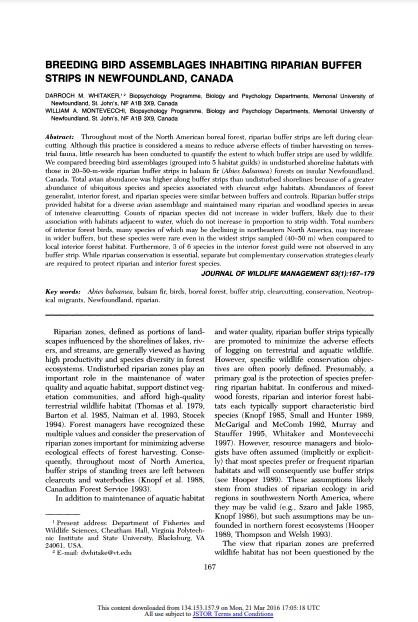Breeding bird assemblages associated with riparian, interior forest, and nonriparian edge habitats in a balsam fir ecosystem
Bosque Modelo:
Western Newfoundland
Temática:
Gestión forestal
Tipo de documento:
Artículo científico
Resumen
Riparian zones are typically viewed as the highest quality habitat available to wildlife in forested landscapes, and consequently are seen as being the most biodiverse. This perception originated largely from studies conducted in southwestern North America; however, its validity in boreal forests remains relatively untested. We surveyed breeding bird assemblages along transects in riparian edge, nonriparian edge (clearcut or access road), and interior habitat in balsam fir (Abies balsamea (L.) Mill.) forests in Newfoundland. Distinct species assemblages were associated with each of these habitat types. Notably, five species were significantly more common in interior forest than along riparian edges. Total abundance and species richness did not differ between riparian and interior forest transects, but were significantly higher on nonriparian edge than riparian transects. Distinct species were characteristic of the two edge types, and no generalist edge species were identified. Based on this and other recent studies, it is apparent that relatively high riparian biodiversity may be the exception for bird assemblages in coniferous and mixedwood forests. Interior forest species, many of which have declined in northeastern North America in recent years, formed an important component of the regional avifauna. These species are likely not afforded adequate protection in boreal forests, where conservation efforts focus on preserving riparian habitat.
Información Bibliográfica
Autor:
Whitaker DM and WA Montevecchi.
Revista:
Canadian Journal of Forest Research
Año:
1997
N°:
-
País :
Canadá
Páginas:
1159 - 1167
Volumen:
27
Idioma:
Ingles
Palabras claves
Abies balsamea, balsam fir, birds, boreal forest, buffer strip, clearcutting, conservation, neotropicalmigrants, Newfoundland, riparian





